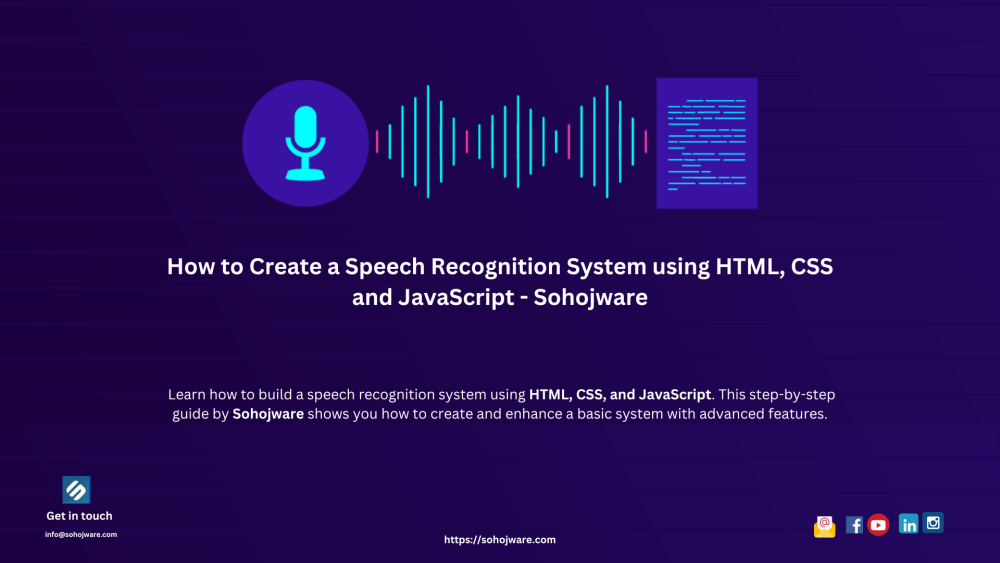The way we interact with technology is constantly evolving. Gone are the days of clunky keyboards and endless typing. Speech recognition systems, a form of Artificial Intelligence (AI), have emerged as a powerful tool, allowing us to interact with our devices through the power of our voice. This technology has many applications, from creating voice-controlled assistants to transcribing audio recordings.
In this article, brought to you by Sohojware, a leading US-based software development company, we'll delve into the exciting world of speech recognition systems and guide you through building a basic one using HTML, CSS, and JavaScript.
What is a Speech Recognition System?
A speech recognition system (speech recognition system), also known as Automatic Speech Recognition (ASR), is a technology that converts spoken language into text. Imagine being able to dictate emails, search the web, or control your smart home devices using just your voice. Speech recognition systems are making this a reality, transforming the way we interact with computers and the digital world.
Benefits of Speech Recognition Systems
Speech recognition systems offer a multitude of advantages, including:
-
Increased Accessibility: Speech recognition systems empower individuals with disabilities or those who struggle with typing to interact with technology more easily.
-
Enhanced Productivity: Speech recognition systems can significantly boost productivity by allowing users to dictate tasks and commands instead of manually typing.
-
Improved Accuracy: Speech recognition systems can potentially reduce errors by eliminating the need for manual data entry.
-
Hands-free Interaction: Speech recognition systems enable hands-free control of devices, allowing for multitasking and greater convenience.
Building a Basic Speech Recognition System with HTML, CSS, and JavaScript
Sohojware is dedicated to empowering developers and enthusiasts of all levels. Here's a step-by-step guide to creating a simple speech recognition system using these fundamental web technologies:
1. HTML Structure
First, we'll establish the basic structure of our web page using HTML. Let's create an index.html file with the following code:
This code creates a basic HTML document with a title, a link to a CSS stylesheet (style.css), and a container (div) for our speech recognition system. Inside the container, we have a button to initiate recognition and a div to display the recognized text (transcript). Finally, we include a script tag that references an external JavaScript file (script.js) containing the core functionality.
2. CSS Styling (style.css)
Now, let's add some visual appeal to our application using CSS:
This code simply styles the elements within our speech-container div, providing a centered layout, margins, and basic button and text styling. You can customize these styles further to match your preferences.
3. JavaScript Functionality (script.js)
The magic happens in the JavaScript code. Here's what goes inside the script.js file:
This code:
-
Retrieves elements: Select the start button and transcript element from the HTML document.
-
Adds event listener: Attaches a click event listener to the start button.
-
Creates recognition object: Initializes a webkitSpeechRecognition object.
-
Sets language: Specifies the language for recognition (in this case, English-US).
-
Handles results: Defines a callback function for the onresult event, which is triggered when the recognition engine receives speech data. The recognized text is extracted and displayed in the transcript element.
-
Handles errors: Defines a callback function for the onerror event, which is triggered if an error occurs during recognition. The error message is logged to the console.
-
Starts recognition: Begins the speech recognition process by calling the start() method on the recognition object.
Additional Considerations
-
Browser Compatibility: While webkitSpeechRecognition is widely supported, it's essential to consider browser compatibility and provide alternative solutions for older browsers.
-
Error Handling: Implement more robust error handling to provide informative feedback to the user in case of recognition errors.
-
Accuracy: Experiment with different language models and settings to improve recognition accuracy for specific use cases.
-
Privacy: Be mindful of privacy concerns when handling speech data, especially in sensitive contexts. Consider using secure and privacy-preserving technologies.
Conclusion
By following these steps and leveraging the power of HTML, CSS, and JavaScript, you can create a functional speech recognition system that enhances user interaction and opens up new possibilities for your web applications. Sohojware, a leading US-based software development company, is committed to providing innovative solutions and empowering developers like you to build cutting-edge applications.
FAQs
-
How can I improve the accuracy of my speech recognition system?
-
Experiment with different language models and settings.
-
Consider using a cloud-based speech recognition service for higher accuracy.
-
Provide clear and concise prompts to guide the user's speech.
-
Can I use speech recognition to control other elements on my web page?
-
Absolutely! You can use JavaScript to trigger events or manipulate elements based on the recognized speech.
-
How can I ensure privacy when using speech recognition?
-
Consider using secure and privacy-preserving techniques to handle speech data.
-
Inform users about your privacy practices and obtain their consent.
-
What are some common use cases for speech recognition systems?
-
Voice-controlled assistants
-
Transcription of audio recordings
-
Accessibility features for individuals with disabilities
-
Hands-free control of devices
-
Can Sohojware assist me in developing a more advanced speech recognition system?
Yes, Sohojware offers custom software development services to help you create sophisticated speech recognition systems tailored to your specific needs.




